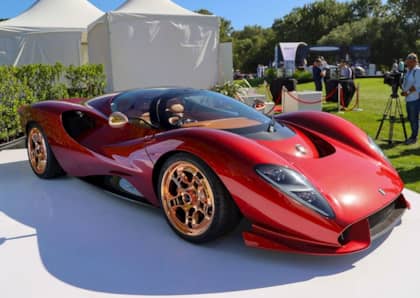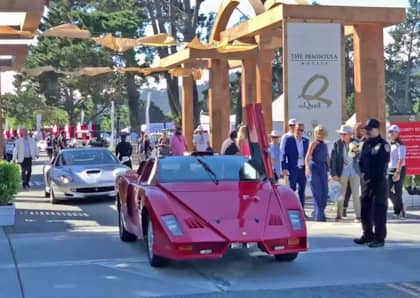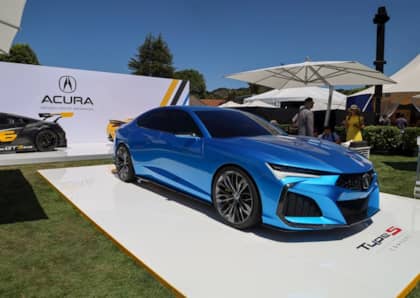The Greatest Supercar Ever? Celebrating 25 Years of the McLaren F1 at The Quail
Of all the brands currently building high performance cars, McLaren might be the one that has the most fascinating, up and down history as a road car builder. The brand’s racing exploits and list of accomplishments on a circuit are long and legendary, but unlike Ferrari or Porsche, its production car heritage is much less linear.

These days McLaren Automotive is known as one of the world’s premiere supercar builders and in less than a decade it’s gone from non-existent to being one the most respected auto makers in the world, offering an array of different models, each one appearing more extreme than the next.

But if you go back in time a bit—25 years to be exact—there was just a single production vehicle that wore a McLaren badge. At the time it was one of the fastest, most radical road cars ever built and its appreciation (and value) has only gone up with age.

We are talking of course about the McLaren F1, which originally debuted in 1994 with a state-of-the-art, carbon fiber chassis and a naturally aspirated V12 engine sourced from BMW. And despite its age the F1 still has a performance credentials that can rival many of today’s best supercars.

All in all, 106 examples of the McLaren F1 were built between 1994 and 1998 in both road and race trim, and to celebrate the car’s 25th anniversary, this year’s edition of The Quail: A Motorsport Gathering featured a special display on the F1 with four different examples in attendance.

Not only was it impressive to see four different McLaren F1s gathered in one place, but The Quail did a fine job of curating a display which highlighted the evolution of the car during its four-year run during the 1990s.

One of the first things that might strike you about the McLaren F1, is that despite using what's still considered highly advanced technology the overall of the look car is still much simpler and constrained than today's aero-laden supercars and hypercars—even with the high downforce kit that's been added to the white 1994 model pictured below.

What's especially interesting about the F1 is that total of 106 examples includes 28 cars which were built specifically for race use, dubbed F1 GTR—the competition version of the car was represented at The Quail by this "Longtail" model from 1997.

Not surprisingly, the Longtail gets its name from the new bodywork that extended both the front and rear of the car in order to generate more downforce. While the Longtail GTR is still easily identifiable as an F1, it ended up taking on an entirely different look when compared to the road car.

One of the most unique things about the F1 was that in street trim it featured a center-mounted driver's seat with a smaller passenger seat on each side, and this also allowed for an easy conversion to race trim with a prototype-esque seating position.

The racing versions of the F1 ended up building a list of accolades that was as impressive as their road-going counterparts, including an outright victory at the 24 Hours of Le Mans in 1995 with the Tokyo Ueno Clinic car. To commemorate the F1's success at Le Mans in 1995, there was a special edition of the car built called the F1 LM.

Only six examples of the F1 LM were ever built, with most of them painted in McLaren's signature Papaya Orange racing color. While the standard F1 was designed to be rather comfortable in street driving the LM was stripped down and focused for the track, weighing about 130 pounds less than the regular car.

The F1 LM also featured the same engine F1 GTR, albeit without the class restrictions—resulting in a total output of 680 horsepower vs. 600 in the race car and 671 in the normal F1 road car.

Rounding out the group of four cars that were on display at The Quail is a metallic orange-colored 1998 model, which represents the final year of McLaren F1 production and the end of the story for one of the world's most important supercars.

Following the end of F1 production in 1998, the road car side of McLaren would stay largely dormant until the brand returned in 2010 to begin a whole new era of supercar performance, though in a much more mainstream way than we saw with the F1 in the mid '90s.

Since the brand's return in 2010, there have been some truly wild cars to wear the McLaren nameplate, including the P1 and more recently the Senna—but for as crazy and fast as those cars are there will never be anything quite like the McLaren F1 again with its naturally aspirated V12 and manual gearbox.

While its outright performance may have been eclipsed by the advanced technology of todays's supercars and hypercars, after checking out these four examples up close at The Quail its easy to see why some consider the McLaren F1 to be greatest supercar of any era.
Be sure to check out the rest of our coverage from the 2019 Quail including a look at five of the most exciting vehicles from the show.











